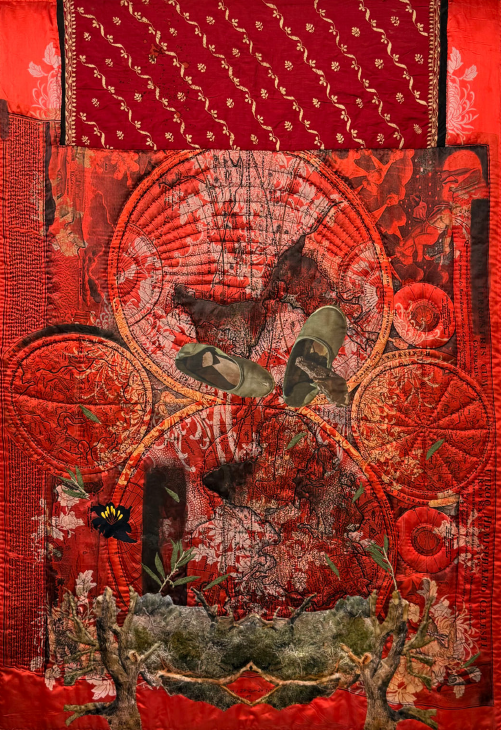Fabric has been used as a medium of storytelling ever since the history of art began, and this isn’t surprising considering the strong cultural memor
Fabric has been used as a medium of storytelling ever since the history of art began, and this isn’t surprising considering the strong cultural memory and history a piece of fabric can hold. From the battle depicting tapestries in medieval Europe to the hand-woven textiles in South Asia that are rooted in history, fabric encompasses everything of preservation of one’s identity and evolution. For contemporary artist Risham Hosain Syed, the fabric becomes a link between the self and the collective, the yesteryears and the present.
Syed’s latest exhibition, Chait Vasraand: What the Rain Remembers, presented at Canvas Gallery, draws on this deep legacy. It is one of such many that explores the desire to use what remains of man—future despair—and comprehend the planet. It is a relation of intricately layered memories filled with silk that was inherited, a softer portrayal of the many harsh calamities witnessed by the world. Such a portrayal, as she sought to achieve through her art, tells of strength and defiance, beauty and horror instantiated by the struggles woven into every artifact.
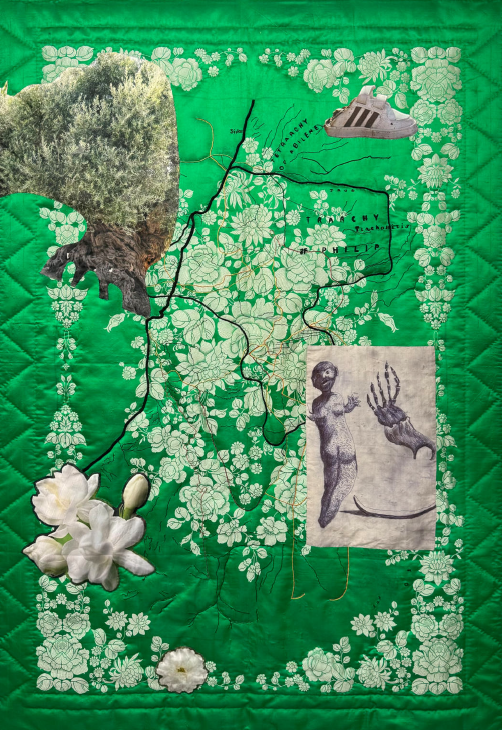
What follows is an exhibition through her evocative and alluring creations—the perfect confluence of color, texture, and meaning—that serve as a reminder of the importance of remembrance, the interconnectedness of humanity and everything that binds us to history.
Risham Hosain Syed, a celebrated name in the art world, continues to engage audiences through her evocative work. At first glance, her works might appear complex and not so easy to decipher, but as one goes closer and tries to connect with the artist’s narration, one finds their personal experiences and her commentary parallel. This layered engagement underscores Syed’s ability to craft works that are both deeply personal and universal.
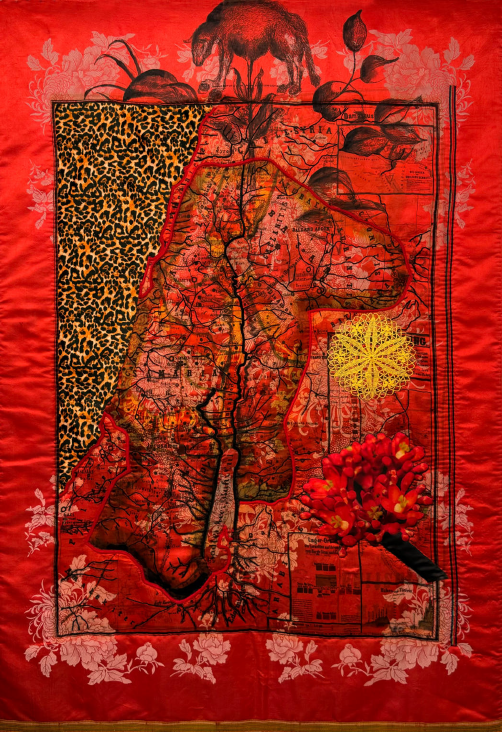
Artists often pick subjects that are closer to their hearts yet Syed’s oeuvre is not all about personal encounters or her memories. She showcased an exceptional set of work which revealed a heavily layered approach. The prime or the foundation layer is the fabric; the luxurious and fine silk.
These are not a few pieces of cloth stitched but they hold memories. Syed put the base of her work with something that was her own, personal and close to her heart. This silk fabric, as she has mentioned in her statements, is inherited from her mother.
“My mother collected Chinese silk in the 1980s when pilgrims from China passed through Pindi on their way to Hajj. They sold silk and pearls along the way, creating a trade route of sorts. When I received the silk, it transported me back to that time. I could never wear it. Now, in my 50s, I realized how decades slip by while holding onto things we plan to use ‘someday.’ I preserved its originality while incorporating it into my artwork.”
Syed’s previous exhibitions have also featured this silk, notably a show two years ago where she explored themes of world trade and globalization through the lens of the China-Pakistan Economic Corridor (CPEC). “Those concerns influenced my work. I used the same silk but incorporated different imagery, and the context was completely different,” Syed explained when I inquired about her use of cloth.
The brilliance of Syed’s art lies not only in its conceptual depth but also in its execution. The vibrant colors she employs are not mere aesthetic choices; they stem from her reflections on world power dynamics. The theme, which could be called the second layer of her work, addresses genocide and brutality particularly the ongoing crisis in Gaza. During our conversation about her work she revealed that the color palette of red and green was inspired by her reflections on Gaza. Her works, rich in detail, traverse nostalgia, global politics, power dynamics, and human suffering—all viewed through the lens of Gaza’s plight.
“Historical artifacts have often been taken from Gaza, surviving while real lives have been lost,” Syed noted. “These reflections shaped my panels.”
When one takes eyes off of the fabric, and vibrant colors and deciphering the theme, then the intricate elements such as vegetables, flowers, Roman ruins, animals, monsters, motifs and stitching catch attention which could be called the third layer which acts as a metaphorical pathway to connect disparative stories into a whole.
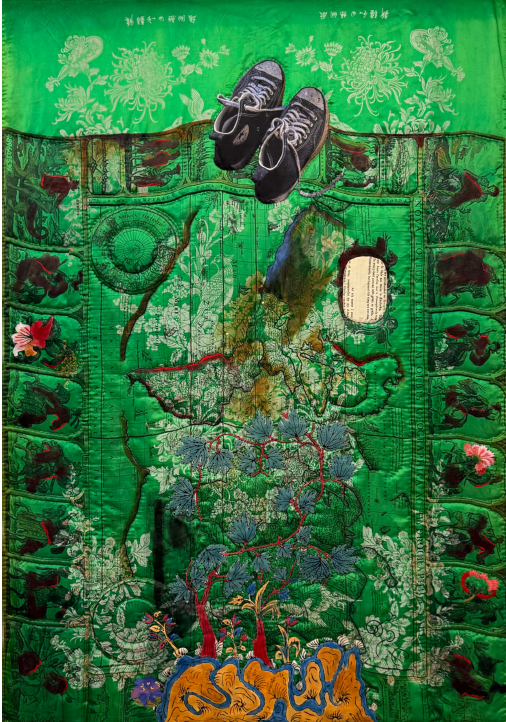
“The stories like that of a young boy with an agricultural degree who grew vegetables amid displacement. Ultimately, he was targeted for feeding others. Such events became integral to my creative process.” Syed explained mentioning an article she read in about a young Palestinian boy who was killed.
A lot of elements in her work are explored through the context of Palestine. Syed has also reflected on what we collect and what we leave behind. In this exhibition, she connects personal to the global. As a sensitive topic was becoming part of her creative process, she did not want to use anything new but decided to use what was saved and left for her by her mother. “We accumulate so much material; we don’t always need to buy new supplies to create. I used collected fragments — labeled and stored — and incorporated the silk I already had.”
There is one pertinent and recurring symbol that Risham has used is a pair of shoes in every piece which indicates the tension in Gaza. When one takes Blood-red stains, intuitively placed, evoke the region’s ongoing turmoil. Syed’s use of motifs such as olive trees and Roman ruins further amplifies her commentary on displacement, resilience, and cultural memory.
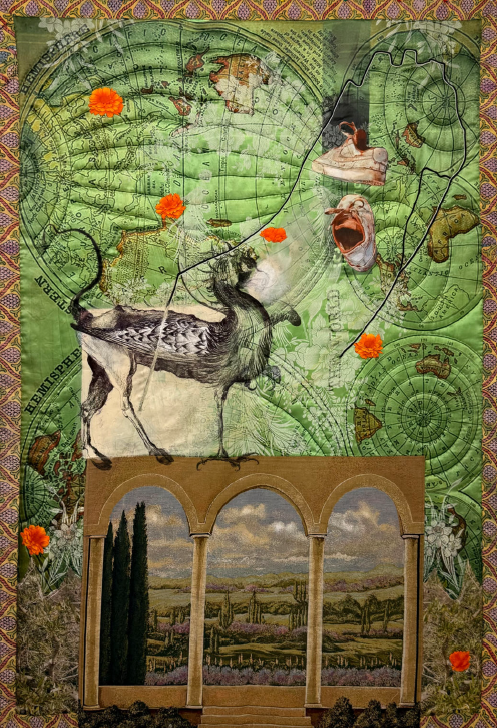
Fabric emanates, and cut-offs also indicate recreation and reimaging of her art practice. The large-scale work might look like a piece of cloth that is embroidered and full of motifs. It also has minute detailing, which has been kept in mind cautiously while creating these wonderful and striking pieces. Certain items like the printed olive trees and shoes came from outside, but many materials, such as crochet and striped fabrics, were from her home. This speaks to her commitment to preserving the original essence of these fragments. One pink-and-white striped fabric was part of her mother’s wedding outfit, a keepsake she always wanted her to wear.
“I did not cut or re-create anything and tried not to disturb the originality as it was my wish not to change anything as the archival significance of the fabric should remain the same even if it’s looked at after ages. That is what the beauty of archives.”
Every panel contains such fragments. The broader narrative relates to our shared experiences and historical memories. “The silk that I inherited from my mother has an emotional and personal touch and during the creative process it transformed into something in history and world politics and the same silk stays in the most originality and starts conveying the message of the world.”
The title also suggests and concludes the overall concept of the show ‘What the Rain Remembers’ is what is left behind is remembered such as fragments left behind. Syed is also preparing for two major exhibitions in 2025: the Sharjah Biennale and a show at the New Museum. Balancing these alongside her Canvas Gallery exhibition has been a unique challenge. “Each project requires different inputs,” she shared. “What the Rain Remembers demanded physical material with a personal and emotional touch. It was therapeutic and cathartic. The work explores the senselessness of global crises and the ugliness of systems that prioritize personal gain over humanity.”
From the delicate motia flowers reminiscent of her grandmother’s era to the bold commentary on global crises, Syed’s work defies simple categorization. Her art invites viewers to reflect, question, and connect, making “What the Rain Remembers” a profoundly moving exhibition. Syed’s use of fabric—a symbol of comfort and identity—transforms personal inheritance into a medium for cultural dialogue and political debate.
